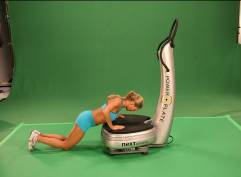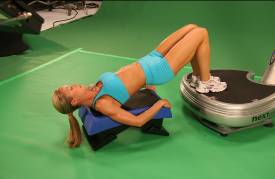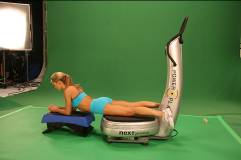Power Plate Education
Multiple Sclerosis
Multiple Sclerosis is a chronic, inflammatory disease that affects the central nervous system (CNS). It affects the neurons, the cells of the brain and spinal cord that carry information and allow the brain to control the body. Surrounding and protecting some of these neurons is a fatty layer known as the myelin sheath, which helps neurons carry electrical signals. MS causes gradual destruction of this myelin (demyelination) in patches throughout the brain and spinal cord. The name multiple sclerosis refers to the multiple scars (or scleroses) on the myelin sheaths. This scarring causes symptoms which vary widely, depending upon which parts of the nervous system are affected. The most prevalent symptoms are muscle weakness, coordination problems, numbness, slurred speech, changes in sensation, blurred vision, tremors, fatigue and pain, but some patients will also experience depression, problems with concentration and memory, problems with balance and overheating. It will often cause impaired mobility and even disability due to paralysis in more severe cases.
Multiple sclerosis relapses are often unpredictable and can occur without warning with no obvious inciting factors. Some attacks, however, are preceded by common triggers like the hot season, infections, emotional and physical stress, severe illness, extreme strenuous exertion, heat, and pregnancy in the first six months. There are several types of MS; the most common one is the relapsing remitting type where the patients experience sudden loss of function which is regained after several days or weeks. In some people, multiple sclerosis is only a mild illness, but it can lead to permanent disability in others. Depending on the type of MS the disease will worsen progressively, which is why it is extremely important to maintain a certain level of fitness as long as possible.
Multiple sclerosis and concerns for exercise:
- If the patient presents cardiovascular dysautonomia (irregular function of the autonomic nervous system that leads to a blunted heart rate and decreased blood pressure in response to exercise), heart rate and blood pressure must be monitored throughout the exercise program, and intensity may need to be decreased
- Heat sensitivity
- Incontinence (loss of control of bowel/bladder)
- Spasticity/tremor – focus on areas of muscle imbalance, engage in gentle rhythmical/active flexibility exercises before exercise and in static flexibility movements after exercise that focus on increasing mobility and lengthening of tight areas
- Lack of balance and coordination – this may lead to dangerous falls – choose exercises providing maximum support and check with a professional to design a program that incorporates balance and coordination training
- Medication may affect energy level, muscle coordination and muscle strengh
People with MS usually suffer from off days. Symptoms are fatigue, soreness, sleepiness, decreased functionality etc. If they do decide to train on such a day, we advise against trying to motivate them to give their best. Make sure to prepare a ‘bad day’ training, consisting of only recovery and regeneration exercises, as physical exertion on these days increases the chance of overtraining.
Multiple Sclerosis and the Power Plate:
Acceleration Training on the Power Plate may help patients suffering from MS in the following ways:
- Decreasing spasticity and muscle imbalance through flexibility training and massage of tight muscles
- Fighting atrophy by performing strength exercises on the Power Plate
- Improving coordination and control of movement by performing stability exercises on the Power Plate (single leg or unsupported exercises)
- Improving stability and strength in all planes of motion (because of the multi-dimensional displacement of the platform)
- Decreasing pain sensations due to the high stimulation of the mechanoreceptors (muscle spindles and Golgi tendon organs) and the desensitization of the pain receptors
- Improving intra-muscular and inter-muscular coordination (and therefore improving motor learning and motor control) because the fast rate of muscle contraction induces the motor units to switch on at the right time, at the right speed and in a synchronized way
- Relieving depression as a result of an increase in the production/release of serotonin (serotonin is considered the “feel good” hormone)
- Improving bladder control by enhancing the neuro-response and improving the strength of the pelvic floor muscles
What to avoid:
Prevent overtraining. Start with just a few minutes on a very low level. For patients with MS, rest may be even more important than exercise. They recover at a much slower pace and will therefore require more time to recuperate, and after overtraining there is a major risk of relapse and severe consequences. This may take weeks to overcome, and some patients may never regain the same level of fitness.
As MS patients may lose control of major muscles at any time, be prepared for sudden falls and spasms, and make sure you can catch them when this happens. Also keep in mind that due to the “top down” approach of muscles, some patients may be able to control their muscles during vibration, but cannot maintain this control once the stimulation ends.
What to do:
Focus on strength (to improve muscle weakness and increase energy level through hormonal release) and on the stability and coordination components of training (to improve motor control and balance). Other important modalities that should be incorporated in the training routine of patients with MS are movement preparation and regeneration exercises (to increase flexibility and decrease tension in tight or spastic muscles).
Therapy section:
Guidelines for exercises and execution:
When training clients with MS, pay special attention to the strength exercises (to improve muscle weakness and increase energy level through hormonal release) and stability and coordination exercises (to improve intra- and inter-muscular coordination, motor control and balance). Focus on functional movement patterns and muscle function. Certain exercises will be extremely beneficial to the overall quality of life. Other important modalities that need to be included in the training routine are flexibility exercises (through movement preparation) and regeneration exercises (to decrease tension and pain sensations in tight or spastic muscles).
Keys:
Try to make efficient use of the amount of energy these clients have – this level is highly individual and will also vary greatly from one day to the next. Make sure they spend the power they have on exercises that will help them performing actions they need in everyday life, such as standing up, moving between chair and bed etc. Remind your clients to void their bladder before beginning their session. Ensure that the intensity is based on your client’s level of energy. Ensure safety during training by providing support, especially when performing stability and coordination exercises. Give positive reinforcement during training to promote enjoyment and adherence to the program.
Programming and progression guidelines for the therapy:
Stability and Coordination exercises are mainly intended to improve proprioception and balance, but will need to be performed in a safe environment (provide support if needed). Examples of stability exercises are the Single Leg Balance and the Single Leg Excursions.
Strength exercises are crucial for MS clients and should target the major muscle groups. Examples of exercises are the Squat, the Lateral Squat, the Standing Pull, the Modified Push-Up and the Kneeling Single Arm Overhead Press.
Core and Pillar exercises are important to improve movement efficiency and stability. An example of pillar exercise is the Glute Bridge (performed with wide stance and preferably using a step) and the Lateral Plank.
Recovery and Regeneration should incorporate myofascial applications to decrease muscle tension and pain sensations. Examples of massages are the Hamstring Massage, the Lower Back Massage, the Shoulder/Neck Relaxor and the Quad Massage.
These are “suggested” protocol by users of Power Plate not necessarily endorsed by Power Plate Inc.
Use at your own risk/ Consult your physician.






















